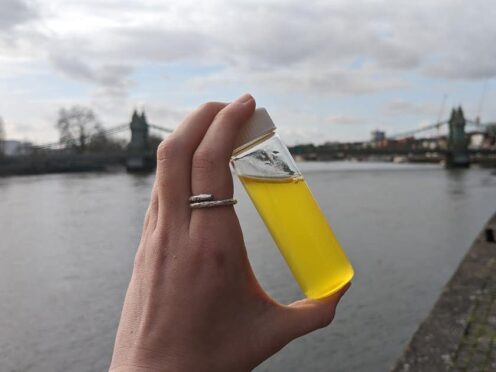High levels of E.coli have been found along a stretch of the River Thames that will be used for the historic Oxbridge Boat Race this weekend, researchers said.
The bacteria, which can cause serious infections, was discovered during regular testing by River Action and the Fulham Reach Boat Club between February 28 and March 26, using a World Health Organisation-verified E.coli analyser.
The 16 tests around Hammersmith Bridge in west London indicated an average of 2,869 E.coli colony forming units (CFU) per 100ml of water.
To meet the Environment Agency’s inland bathing water quality standards, the level should be below 1,000 CFU per 100ml.
River Action said the highest level it recorded was 9,801 CFU per 100ml, meaning it was nearly 10 times higher than levels found in bathing waters graded as “poor” by Environment Agency standards.
The Government advises against bathing in water at this grade, which is the lowest of the four possible categories.
River Action said the testing locations suggested the source of pollution is from Thames Water discharging sewage directly into the river and its tributaries.
This is based on publicly available data which showed that the water company had discharged sewage into the Greater London area of the River Thames for 1,914 hours from the start of 2024 up to March 26. This is equivalent to 79 out of the 85 days.
The findings come ahead of the annual Gemini Boat Race between the University of Oxford and the University of Cambridge on Saturday.
River Action, British Rowing and The Rivers Trust have issued new guidance to rowing clubs across the UK on safety in polluted waters, which has been included in the Gemini Boat Race briefing packs to both universities.
Rowers are advised on the importance of covering cuts, grazes and blisters with waterproof dressings, taking care not to swallow river water that splashes close to the mouth, wearing suitable footwear when launching or recovering a boat, and cleaning all equipment thoroughly.
River Action chief executive James Wallace said: “We are in a tragic situation when elite athletes are issued with health guidance ahead of a historic race on the capital’s river.
“Our water quality results show what happens after decades of neglect by an unregulated water company, Thames Water.”
The organisation said rowers, communities and conservationists are uniting to ask the Government to enforce the law and prosecute polluters.
“Everyone should be able to enjoy our rivers and seas without risking their health,” Mr Wallace said.
World champion Imogen Grant, who was also a triple Boat Race winner with Cambridge, said: “As a rower, the water I row on is my field of play, and the results of the E.coli testing show that rowers are putting their health at risk to do the sport they love.
“Thousands of people rely on our rivers for work and recreation and they are being choked with sewage and pollution.
“More needs to be done to improve our water quality across the country, and testing like this gives us a picture of just how far we have to go.”
The E.coli bacterium, which is found in faeces, can cause a range of conditions, including urinary tract infection, cystitis, intestinal infection and vomiting, with the worst cases leading to life-threatening blood poisoning.
A Thames Water spokesman said: “Taking action to improve the health of rivers is a key focus for us and we want to lead the way with our transparent approach to data.
“We have experienced higher than average long-term rainfall across London and the Thames Valley, with groundwater levels exceptionally high for the time of the year.
“We are working hard to make these discharges unnecessary and have published plans to upgrade over 250 of our sites, including a £100 million upgrade of our Mogden sewage treatment works in south-west London to treat the high volumes of incoming sewage and reduce the need for overflows during wet weather.”
The PA news agency has contacted the Department for Environment, Food and Rural Affairs (Defra) for comment.
